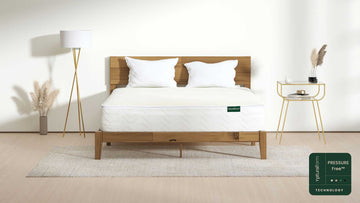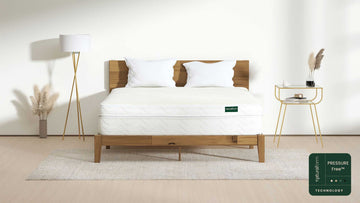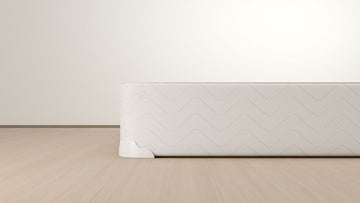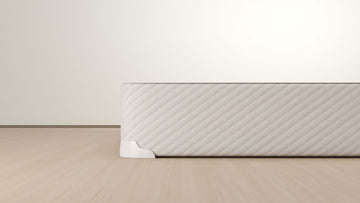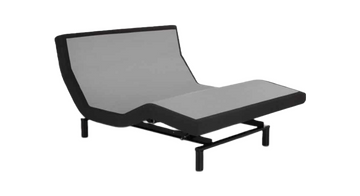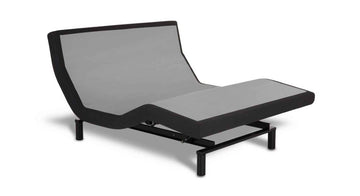What is an adjustable bed?
An adjustable bed is a bed that allows the user to adjust the position of the mattress. Rather than providing a static, flat surface, adjustable beds offer motorized controls that can be used to elevate areas of the bed for enhanced comfort – for example, the head of the bed can be raised higher than the feet.
What is the primary purpose of an adjustable bed?
As mentioned, the core feature of adjustable beds is their ability to provide an angled sleeping service. When originally used in medical settings, this was found to provide a number of different health benefits, including improved circulation and a reduction in bodily pain or swelling.
Over time – and particularly with the introduction of adjustable beds into the domestic market – the core functionality has been added to with a number of extra features. For example, the inclusion of features such as massaging surfaces, remote or wireless controls, silent alarms, and sleep trackers, all capable of greatly enhancing the user experience.
Who can benefit from an adjustable bed
In truth, everyone can benefit from an adjustable bed thanks to the optimal sleeping position this type of bed is able to achieve. However, certain groups will usually find that adjustable beds are particularly suited to their needs, helping to provide relief from a range of different health conditions. For example…
- Heavy snorers benefit greatly from the ability to elevate their head while sleeping
- People who experience sleep apnea benefit for the same reason, with a higher head position helping to promote a clear airway during sleep
- As mentioned above, adjustable beds are known to help improve circulation, so people who experience issues in this regard should experience relief
- Many adjustable beds offer dual customization options, which means that each half of the bed can be adjusted to fit individual requirements – a particularly beneficial feature for couples who wish to share a bed, but who have very different sleeping preferences
- People who are recovering from medical procedures and injuries can also – unsurprisingly, given the original intended purpose of this type of bed – greatly benefit from adjustable beds
- Finally, people who experience back pain are especially suited to an adjustable bed, as we will discuss in more depth below
The relationship between sleep position and back pain
Back pain is an incredibly common medical condition; estimates suggest that up to 80% of people will experience back pain at some point in their lives. Due to the commonality of back pain, the role of adjustable beds in providing relief to the condition is worthy of particular focus.
In isolation, it may seem odd to suggest that a bed alone can help to alleviate back pain. Back pain is often seen as a secondary symptom, resulting from an underlying medical condition or injury. However, one of the leading causes of back pain is actually a far simpler issue: poor posture. When someone sits, stands, or lies down incorrectly, the muscles in their back can be greatly impacted, causing pain that is, in some cases, incredibly severe.
Given that the vast majority of people sleep for between six and eight hours per night, the problems caused by lying in a poor position are significant. The way that people sleep at night considerably impacts their overall health and mobility; if they sleep well, with their body position correct and adequately supported, they will likely experience less back pain. Conversely, if they sleep poorly and without sufficient support, occurrences of back pain during the day are far more likely.
How can adjustable beds help alleviate back pain?
Adjustable beds have a vital role to play in achieving an optimal sleeping position. This type of bed can be adjusted to suit the user’s specific body shape, allowing for complete customization in order to achieve a good, well-supported sleeping position.
So, while we have established that adjustable beds can help the user to achieve a good sleeping position, we now need to define what that position actually is – and why adjustable beds are the preferred choice for achieving it. The key to this issue is relatively simple: the ability to sleep on an incline.
Many people who experience chronic back pain find that sleeping on a slope is incredibly beneficial, helping to reduce instances of pain and improve their overall mobility as a result. Medical professionals tend to concur with this judgment, agreeing that sleeping on an incline can be incredibly beneficial for those seeking to alleviate musculoskeletal issues such as back pain.
There are numerous reasons why sleeping on an incline has received such widespread support. A slope allows for greater support beneath the knees, which helps to relieve pressure on the spine. Furthermore, a slight upper body incline, complete with elevated knees, helps to support the natural curve of the spine during sleep. These benefits are particularly noteworthy for those who sleep on their side.
It is possible to achieve an incline without the use of an adjustable bed, but this is generally not advised. Some people use pillows to elevate the knees, but this tends to produce uneven support; it may alleviate strain on some areas, but can actually worsen the strain in others. Additionally, there is also an issue in that pillows placed between the knees can become dislodged over the course of a night as a person naturally moves during sleep, which eventually results in the individual once again sleeping on a flat, uncomfortable mattress.
Given the facts above, adjustable beds are by far the best option for those looking to alleviate back pain. The bed can be customized to provide the much-needed incline, and the incline allows for consistent support that remains in place throughout the night.
What are the main features of an adjustable bed?
Thus far, we have established that adjustable beds are incredibly important for anyone seeking to improve their overall health and mobility, with a particular focus on the benefits for those with back pain. Now, we’ll turn our attention to the features that allow adjustable beds to achieve these benefits.
It is worth noting that the following features are not necessarily available on every adjustable bed available. As with any product, different adjustable beds offer different capabilities, but here’s an overview of the options available…
- The ability to adjust the firmness of the lumbar support provided
- Massage functionality, including massage features that can work as an alarm clock in order to achieve a gentle, comfortable start to the day
- A timer that allows the bed to return to a more conventional flat arrangement, if preferred, when the user has fallen asleep
What types of adjustable bed are available?
Adjustable beds are usually sold in the following sizes:
- King
- Split King (Two Twin XLs)
- Queen
- Split Queen
- Full XL
- Twin XL
Furthermore, adjustable beds can also be “split” queen or king size beds. We touched on this functionality earlier; essentially, it means that two adjustable mattresses, with their own individual programming abilities, are placed side by side to form a single “bed”. This allows two users to set their own sleeping environment, though this can be inconvenient; there is usually a space where the two mattresses meet, but most couples will adjust well to this over time.
What are the pros and cons of adjustable beds?
Pros
- As discussed, adjustable beds can help to provide pain relief, which is particularly critical for those suffering from musculoskeletal conditions such as arthritis and degenerative disc disease
- The best adjustable beds also help to lessen snoring thanks to preferable elevation of the head; the same benefit is also important for those who experience sleep apnea
- Most people find that adjustable beds are more comfortable, especially as the bed can be adjusted to accommodate non-sleeping activities people often do in bed, such as watching TV or reading a book
- Those who opt for “split” adjustable beds can also sleep as per their own individual preferences, so couples can share a bed that is customized to each individual’s needs
- Additional features such as massage functionality can help to relieve pain as well as being inherently relaxing in and of themselves
- Most adjustable beds have a long warranty; around five years is standard for full warranty, while limited warranties are often available for up to 25 years. Warranties cover important elements such as the motor, mechanical components, and the upholstery
- Some people find that their health insurance will pay for an adjustable bed, provided a doctor has prescribed the bed as medically necessary
- Furthermore, if a doctor prescribes an adjustable bed, the user will not be liable for sales tax on their purchase, which helps to make the higher cost of such a bed a little more manageable
- Some medical supply stores will allow people to rent an adjustable bed, which will enable people to try this type of bed for themselves and see if they experience any of the purported benefits
Cons
- Unsurprisingly given the greater functionality they offer, adjustable beds are often more expensive than standard non-adjustable beds – between $1,000 and $3,500 is common, with some options costing as much as $20,000
- Unlike standard beds, adjustable beds are also at risk of mechanical failure, which may mean that the motor ceases to work and the bed cannot be adjusted as the user may hope. However, such issues are rare, and usually covered by the manufacturer’s warranty.
- Due to the mechanical components, adjustable beds are heavier than standard beds; over 100lbs is common, with 300lbs not unheard of – as a result, adjustable beds can be more difficult to move single-handedly. It is also worth noting that sometimes the weight of an adjustable bed can place an excessive strain on the flooring that supports it, so keep this concern in mind when making your purchase
- When compared to standard beds, adjustable beds are more difficult to assemble – though it should be noted that many manufacturers can assemble the bed on behalf of the new owner if this is requested
What to look for when buying an adjustable base
- Many users find that adjustable beds with programmable memory functions are particularly useful; you can establish, for example, a preferred position when reading a book, and then just select this automatically rather than having to adjust the settings every time
- Keep an eye out for a wall hugging feature, as this ensures you will stay close to the nightstand when raising your head and lowering your feet
- Ideally, look for an adjustable bed with a quiet motor, especially if opting for a “split” bed. If the motor is too loud, then you may find that you cannot move your “side” of the bed without waking your partner, which is less than ideal
- You may also find battery backup is useful if you live in an area that is prone to power failures; the backup ensures the functionality of your bed will be maintained when the mains power is out
- It’s worth checking the returns policy of an adjustable bed if you are buying online. As we have mentioned, these beds are heavy, and some online sellers will require you to contribute to the cost of returning the bed if you are unhappy with your purchase.
Is and adjustable base right for you?
In truth, this decision is subjective. Adjustable beds can be incredibly useful, especially for those who are experiencing issues with back pain, sleep apnea, or snoring. However, there is no one product that works for everyone, and there is no guarantee that an adjustable bed will 100% improve any health conditions that you experience.
Nonetheless, adjustable beds can be transformative, with considerable benefits for overall health and well-being. Many people who have made the switch are extremely satisfied with their decision – and there is every chance you will feel exactly the same should you decide to purchase an adjustable bed in future.
